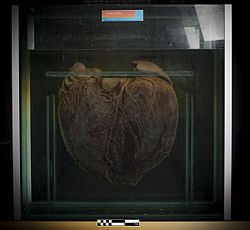Minke whale
The minke whale (also known as the lesser rorqual) is the smallest of the baleen whales that lives in many places in the world. It is the smallest rorqual whale (the large baleen whales). A large one is about 30 feet long and weighs 10 tons. They are black or gray with white on their belly and a white "armband" across their flippers. It is the only baleen whale that is still hunted for money.[1] The Minke whale can swim quite fast.
| Minke whale | |
|---|---|
| File:Minke.jpg | |
| A surfacing minke whale, Skjálfandi, Iceland | |
| File:Minke whale size.svg | |
| Size compared to an average human | |
| Conservation status | |
| Scientific classification | |
| Kingdom: | |
| Phylum: | |
| Class: | |
| Order: | |
| Family: | |
| Genus: | |
| Species: | B. acutorostrata
B. bonaerensis |
There are two types of Minke whale. They are:
- Common minke whale or northern minke whale (Balaenoptera acutorostrata), and
- Antarctic minke whale or southern minke whale (Balaenoptera bonaerensis)
Description
| Multimedia relating to the minke whale Note that whale calls have been sped up to 10x their original speed.
| ||||||||
| ||||||||
The minke whales are the second smallest baleen whale. Only the pygmy right whale is smaller. Males measure an average of 6.9 m (23 ft) and females 7.4 m (24 ft) in length. Both sexes typically weigh 4 - 5 t (3.9–4.9 long tons; 4.4–5.5 short tons) as adults. The maximum weight may be as much as 14 t (14 long tons; 15 short tons). They become adults after 6 to 8 years.
The minke whale is a black/gray/purple color. Common minke whales (Northern Hemisphere variety) have a white band on each flipper. The body is usually black or dark-gray above and white underneath. Most of the back, including dorsal fin and blowholes, appears at once when the whale comes to the surface to breathe.
Minke whales usually live for 30–50 years. In some cases they may live for up to 60 years.
The gestation time for minke whales is 10 months. Calves measure 2.4 to 2.8 m (7.9 to 9.2 ft) at birth. The newborns nurse for five to possibly 10 months. Breeding is mostly done during the summer months. Calving is thought to happen every two years.[2]
Minke Whale Media
Comparison of humpback and minke whale. Illustration by Charles Melville Scammon (1825–1911).
Marinated minke whale meat with sweet potatoes, from Keflavík, Iceland
Video of minke whale breaching in St. Lawrence River near Tadoussac in August 2011. Converted from m4v to ogv file via Miro.
Minke whale in the Ross Sea
References
- ↑ Cole, Joanna. Magic School Bus The Wild Whale Watch. U.S.A.: Scholastic Inc. p. 73. ISBN 0-439-10990-6.
- ↑ http://www.acsonline.org/factpack/MinkeWhale.htm Archived 2012-01-27 at the Wayback Machine American Cetacean Society: Minke Whale





